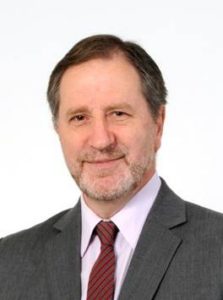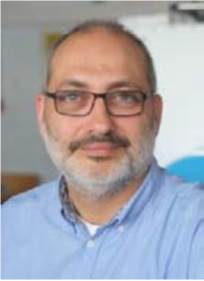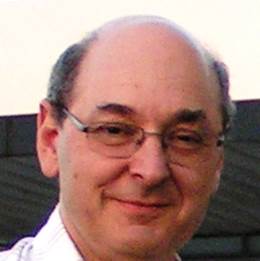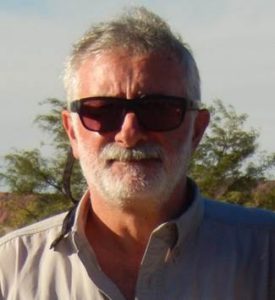
Aldo Felix Craievich is Senior Professor at the Institute of Physics of University of Sao Paulo (IFUSP), CNPq 1A Research Fellow and Co-Editor of Journal of Synchrotron Radiation (Chester, UK). At IFUSP he has been appointed as Head of Department of Applied Physics (2002-2006) and as President of the Research Committee (2007-2008).,en
From 1981 until 1986, Craievich was Full-Researcher at the Brazilian Center of Physical Research (CBPF), Rio de Janeiro, and from 1987 until 1997 at the National Synchrotron Light Laboratory (LNLS), Campinas-SP. At CBPF he was also Coordinator of the Executive Committee of the Synchrotron Radiation Project (PRS/CNPq) and at LNLS he was appointed as Adjoint Director and Head of the Scientific Department. While working at LNLS, he supervised the planning and construction of the first seven synchrotron beam lines and organized an intense and fruitful program for formation of the Brazilian community of LNLS users.,en
From 1965 until 1972 Craievich worked at the Institute of Mathematics, Astronomy and Physics of the National University of Cordoba, Argentina. In 1973 he started his research and teaching activities in Brazil, at the Institute of Physics and Chemistry of São Carlos (IFQSC, now IFSC). At IFQSC (1973-1980) he conducted the first pioneering investigations on glass science in Brazil (1973-1978) and put in operation the first Brazilian small-angle X-ray scattering setup (1973).,en
Craievich received his Bachelor (1964) and PhD (1969) degrees from Instituto Balseiro, Bariloche, Argentina. He performed his PhD work (1966-1969) and his first post-doctoral leave (1976) at Laboratoire de Physique des Solides, University Paris-Sud, Orsay, France; and his second post-doctoral leave at the synchrotron laboratory LURE (1981), at the same University.
The main fields of the research conducted by Craievich are condensed matter physics and crystallography. His investigations include in situ studies of structural transformations in crystalline and vitreous solids, and determinations of mechanisms of transformation and phase transitions in nanoscopic materials. Since 1981 the experimental parts of most of his investigations were carried out at synchrotron laboratories, from 1981 until 1996 at LURE, France, and since 1997 at LNLS.,en
Craievich is author of 260 articles and nine book chapters, and editor of four books, which received 4000 citations circa, with an h index=32. He supervised eighteen PhD (9) and MS (9) theses. He has been elected in 1980 as member of the Academy of Sciences of Sao Paulo State (ACIESP) and, in 2015, as member of the Brazilian Academy of Sciences (ABC). He received formal recognitions/distinctions from LNLS staff and users community (1997 and 2010), Brazilian Society of Crystallography (2000), Instituto Balseiro (2011), and Argentinian Association of Crystallography (2014). He was also co-recipient of the prizes Science and Technology for Mercosul 2004 (Energy) and 2010 (Nanotechnology), awarded by RECYT/UNESCO, MCT (Brazil) and MCTI (Argentina).,en
Summary of Plenary conference
Advanced structural characterization of materials. Relevance and challenges,es
The properties of the materials generally rely more on their structural defects that its structure spatially averaged, which is usually determined by classical X-ray diffraction Defects static and dynamic they can be characterized by measuring the diffuse X-ray intensity between the Bragg peaks . Instruments for studies of the diffuse X-ray scattering at small angles (SAXS) are currently in operation in various laboratories in Brazil and Argentina and also associated with the Brazilian synchrotron light source (LNLS) [1]. Although the techniques of X-ray diffuse scattering provide relevant information, they refer to structures local defects spatially averaged.,es
Abstract of plenary conference
Advanced Structural Characterization of Materials. Relevance and Challenges
Averages in time and space structures determined by X-ray scattering classic can be suppressed using newly developed new sources such as X-ray lasers (XFEL) and fourth-generation synchrotrons. Under favorable conditions, these new X-ray sources used to determine practically instantaneous structures, and / or local structures without spatial average.
They were recently conducted crystallographic studies using XFELs pioneers a series of nanoscopic nanocrystals of a protein and a metal nanocrystal using a single pulse of photons of some tens of femtoseconds. Another example of application of a modern synchrotron source is a recent study in situ discontinuous crack propagation in silicon monocrystals [2].,es
The first two sources of synchrotron radiation fourth generation of the world are currently being built in Sweden and the LNLS [Sirius) [3]. These sources produce X-ray beams with high volumes of consistency, allowing the determination of crystalline and amorphous structures without spatial average.
The efficient use of coherent X-ray sources requires overcoming various challenges related to new developments very stable optical, advanced detectors, procedures in situ preparation of nanoscale samples, complex control systems and methods of treating large volumes of data. Significant progress in all these areas are currently being achieved.
The properties of materials depend more on details of their structural defects than on their spatially averaged structure, which is usually determined by classical X-ray diffraction. Static and dynamical defects can be characterized by X-ray diffuse scattering, which analyzes the diffuse X-ray intensity between Bragg peaks. SAXS setups for the study of diffuse scattering at small angles (SAXS) are currently in operation in several laboratories in Brazil and Argentina and at the Brazilian synchrotron facility (LNLS) [1]. Diffuse X-ray scattering techniques yield useful information related to structural defects but they still refer to space and time averaged structures.
The inherent space and time averaging of materials structures derived from classical X-ray scattering experiments can be suppressed by using recently developed new X-ray sources, namely X-ray free-electron lasers (XFEL) and fourth generation synchrotron sources. Under favorable conditions, these new X-ray sources allow for determining nearly instantaneous structures and local structures without spatial averaging.
A serial crystallographic study of protein nanocrystals using an XFEL and the first structural investigation of metal nanocrystals using a single ten-femtosecond XFEL pulse have recently been performed. Another example of application to materials science of a modern synchrotron X-ray source is a time-resolved study of discontinuous crack propagation in silicon wafers [2].
The first fourth generation synchrotrons in the world are under construction in Sweden and at LNLS (Sirius) [3]. These sources will produce X-ray beams with high volumes of coherence, thus allowing to determine structures of crystalline and amorphous materials without spatial averaging.
The efficient use of coherent X-ray sources requires challenging developments of very stable optics, advanced detectors, in situ procedures for preparation of nanoscopic samples, complex control systems, methods for big-data analysis. Progresses in all these relevant issues are being achieved.
[1] Rodrigues et al J. Synchrotron Rad. 5, 1157 (1998).
[2] Rack et al. IUCrJ 3, 108 (2016).
[3] http://lnls.cnpem.br/sirius/

Esteban P. Busso is currently the Scientific Director of ONERA’s Materials and Structures Branch (approx. 250 permanent staff and 35 PhD students). ONERA is the largest public research establishment in France specialised in aerospace, aeronautics and defense with 1800 permanent staff. From 2005 till 2013 he was a Professor of Mechanics of Materials at the,en Ecole des Mines de Paris and Director of the Ecole’s Mat & eacute Centre; mate- and, from 1994 till 2005, Professor at Imperial College’s Department of Mechanical Engineering in London, UK. Dr. Busso obtained his undergraduate degree from the University of Cordoba, Argentina, in Dec. 1980. In 1985, he joined the Massachusetts Institute of Technology (MIT) in Cambridge, USA, where he was awarded his MSc degree and, in 1990, his PhD degree in Mechanical Engineering. He has also worked in industry in the UK, Japan, South Africa and Argentina. His research involves micromechanics studies of deformation and fracture of materials and interfaces, with an emphasis on the development of multiscale and multiphysics concepts in mechanistic models to predict deformation and fracture processes.,en
In August 2014, Dr. Busso was elected to the British Royal Academy of Engineering. He is a Fellow of the British Institute of Materials, Minerals and Mining and of the Societé Francaise des Matériaux, a Chartered Engineer in the UK and a member of the Royal Academy’s Aerospace Committee. He is currently the associate editor of Philosophical Magazine and until recently of the ASME Journal of Engineering Materials and Technology, and an Editorial Board member and guest editor of the Int. Journal of Plasticity, the Journal of Multiscale Modelling, the Journal of Mechanical Behavior of Materials, the journal of Materials at High Temperatures and the Journal of Materials Discovery. He has authored and edited 12 scientific books, and published over 135 articles in peer reviewed international journals (H-index of 29). He has also organised or co-organised 13 international conferences and more than 16 international symposia in the field of mechanics of materials. He has also taught materials and mechanics courses at the undergraduate and the graduate level for over 25 years. He is an advisor to industry worldwide, to the US Department of Energy, the European Commission, as well as the British, Dutch and French research councils, amongst others.
Appointments
From 11/13 ONERA – NATIONAL AEROSPACE RESEARCH CENTRE, Paris, FRANCE
10/05-10/13 SCHOOL OF MINES PARIS, Materials Centre, Paris, FRANCE
9/94-9/05 IMPERIAL COLLEGE, Dept. of Mechanical Eng., London, ENGLAND
2/92 – 8/94: WS ATKINS SCIENCE AND TECHNOLOGY, Epsom, ENGLAND
9/90 -11/91: HITACHI LTD., Mechanical Eng. Res. Lab., Tsukuba, JAPAN
8/85 – 7/90: MASSACHUSETTS INSTITUTE OF TECHNOLOGY, Dept. of Mechanical Eng. Cambridge, USA
3/85 – 7/85: ATLAS AIRCRAFT CORPORATION, Johannesburg, SOUTH AFRICA
7/83 – 2/85: ELECTRICITY SUPPLY COMMISSION, Test & Res. Dept., Johannesburg, SOUTH AFRICA
8/78 – 6/81: NATIONAL UNIVERSITY OF CORDOBA, Research Centre of Materials, Cordoba, ARGENTINA
Summary of Plenary conference
Current Challenges and Future Materials in Aviation Industry
The performance and reliability of structures and industrial components depend largely on the mechanical, physical and functional properties of the materials involved. Industrial sectors such as aeronautics rely heavily on material development and innovation to maintain a technological edge in a highly competitive global context. In a world where the notion of performance has gradually led to the reliability and environmental protection, it is shown that the behavior of materials is still controlled by their compositions, processing routes and the thermo-mechanical changes that must be optimized . And control materials in processing methods and understanding and prediction of their behavior through sophisticated modeling tools, in conditions as close as possible to those seen in service.,es
At this conference, a summary of the role of materials in designs of current and future aircraft. It will give a historical overview of the role and importance of the materials in the aircraft industry first. This includes examples of how materials defined how aircraft design has evolved over the years, and load conditions that the most critical components of the current and next generation gas turbines, and typical failure modes. It will show that highlights recent developments in materials science and technology are the result of multidisciplinary collaborations between metallurgists, engineers, physico-chemical, physical and material specialists. Finally, the technological and scientific challenges posed by future concepts of civil aircraft, including wing structures with high aspect ratios, and innovative propulsion systems such as those with high bypass ratios, ingestions of the boundary layer will be discussed, buried motors , et propulsion distributed.,es
Abstract of plenary conference
Current and Future Material Challenges in the Aeronautical Industry
The performance and reliability of industrial components and structures depend to a great extent on the mechanical, physical and functional properties of the materials involved. Industrial sectors such as aeronautics depend heavily on materials development and innovation to maintain a leading technological edge in a highly competitive world stage. In a world where the notion of performance has progressively given way to that of reliability and environmental protection, it will be shown that the behaviour of materials is still controlled by their compositions, processing routes and by their thermo-mechanical transformations which need to be optimised. Thus the control of materials lies on the processing methods used and on the understanding and prediction of their behaviour, by way of sophisticated modelling tools, under conditions as close as possible to those seen in service.,en
In this lecture, an overview of the role of materials in current and future aircraft designs will be presented. First, a historical description of the role and importance of materials in the aeronautics will be given. This will include examples of how materials have defined the way in which airplane designs have evolved through the years, the loading conditions that critical components of current and next generation of gas turbine aero-engines are subjected to, and typical failure modes. It will be shown that recent outstanding developments in materials science and technology are the result of a real multidisciplinary collaboration between metallurgists, engineers, physico-chemist, physicists and material scientists. Finally, the technological and scientific challenges offered by existing and disruptive aircraft designs will be discussed, including wing structures with high aspect ratios, and innovative propulsion systems such as those with ultra-high bypass ratios, buried engines, boundary layer ingestion, and distributed propulsion.,en
 Louis F. Marsal is Full Professor at the Department of Electronic, Electric and Automatic Engineering of the Universitat Rovira i Virgili, Spain. He obtained his Ph.D. degree in Physics in 1997 from the Universitat Politècnica de Catalunya. Between 1998 and 1999, he was postdoctoral researcher at the Department of Electrical and Computer Engineering, University of Waterloo, Ontario, Canada.
Louis F. Marsal is Full Professor at the Department of Electronic, Electric and Automatic Engineering of the Universitat Rovira i Virgili, Spain. He obtained his Ph.D. degree in Physics in 1997 from the Universitat Politècnica de Catalunya. Between 1998 and 1999, he was postdoctoral researcher at the Department of Electrical and Computer Engineering, University of Waterloo, Ontario, Canada.
In 2012 he received the URV's RQR Award for the high quality in research and in 2014, he received a 2014 UniSA Distinguished Researcher Award from the University of South Australia (UniSA) and the 2014 ICREA Academia Award from the Generalitat of Catalunya. Since 2013, he is the Chair of Spain Chapter of the IEEE Electron Devices Society. He is a senior member of the Institute of Electrical and Electronics Engineers (IEEE) and of the Optical Society of America (OSA). Dr. Marsal serves as a member of the Distinguished Lecturer program of the Electron Devices Society (EDS-IEEE) He is also member of the Advisory Board of the Research Center on Engineering Materials and Micro/Nanosystems (URV Research Center). He has been member of advisory and technical committees in several international and national conferences and has been visiting professor at several universities and research institutions (CINVESTAV – IPN, McMaster,en
University, ICMM-CSIC, BiomaGUNE, Mawson Institute). He has co-authored more than 200 publications in international refereed journals and conferences, two books, five book chapters and holds two patents. He has presented over 25 invited lectures in international conferences and has participated in over than 80 national and international projects. His current research interests mainly focus on low–cost technologies based on micro- and nanoporous silicon and nanoporous alumina for optical biosensing and biomedical applications. He is also interested in organic and hybrid nanostructured materials to enhance light-matter interactions for optoelectronic devices.,en
Abstract of plenary conference
Electrochemically engineered nanoporous structures for health and energy applications
In the last years structurally engineered nanoporous materials have attracted an increasing interest due to their potential applications in research fields such as electronics, photonic, biotechnology, magnetism, drug delivery, energy, and so on. Porous anodic alumina and porous silicon have become popular materials as a result of their outstanding set of properties and cost-competitive fabrication processes. In this talk, we will present some recent advances in the design and fabrication of micronanostructures based on nanoporous anodic alumina and macro-mesoporous silicon. We introduce different electrochemical approaches to modify the pore morphology during or after the fabrication processes (e.g. straight and well-defined pores, cone-like, funnel-like, modulated, tip-like, etc.) and the design and fabrication of specific structures (microcavities, micro and nanopillars, nanoparticles, Bragg reflectors, rugate filters, etc.) and methods for surface functionalization. In a second part, we will show the use of nanoporous structures as templates and how to create new nanostructures (e.g. nanostructured polymers, nanowires, colloidal fibers). Finally, some relevant applications will be presented and discussed as optical biosensors, cell culture, molecular separation–adsorption, drug delivery, nanostructured solar cells, etc.,en
 Paul David Esquinazi, Actual research interests: Defect Induced Magnetism in Carbon and in (non-magnetic) Oxides, Properties of Oxide Interfaces, Superconductivity in Graphite interfaces.,en
Paul David Esquinazi, Actual research interests: Defect Induced Magnetism in Carbon and in (non-magnetic) Oxides, Properties of Oxide Interfaces, Superconductivity in Graphite interfaces.,en
Professional Career 1999–2002, 2010–2013 Dean of studies of the Faculty of Physics and Earth Sciences in Leipzig. Since 1994 Full time university professor, Leader of the Division of superconductivity and magnetism, University of Leipzig, Germany. 1991 Habilitation at the University of Bayreuth, Germany, Subject: "Vibrating Superconductors”. 1988–1993 Academic adviser at the Division of Experimentalphysik V (Prof. F. Pobell) at the University of Bayreuth, Germany. 1986–1987 Research Scientist at the Comisión Nacional de Energía Atómica" and CONICET, Centro Atómico Bariloche, Argentine. 1983–1985 Research Scientist at the Institut for applied physics II, University of Heidelberg, 6900 Heidelberg, by Prof. S. Hunklinger. 1980-1983 Doctor work at Balseiro Institute, Bariloche, Argentine, Subject: Stability of Metallic Disordered Systems. 1979 Diploma in physics (Thesis supervisor: Prof. Dr. F. de la Cruz). 1974-1979 Studies of physics, University of Tucuman (till 1976), and at the Instituto Balseiro (UNC) at Bariloche (1976-1979), Argentina,en
Summary of Plenary conference
Superconductivity above room temperature in natural graphite crystals
Over the past 40 years, several indications of the possible existence of superconductivity above room temperature in different graphite-based systems were issued without providing, however, any knowledge about the critical temperature superconductor. Through a high precision measurement of the electrical resistance of a glass natural graphite highly ordered from a mine in Brazil, it has been identified with a transition to 350K 40K ~ width. The abrupt change in resistance, irreversibility and time dependence of the magnetoresistance, consistent with trapped magnetic flux and "flux creep", and partial removal of the magnetic flux indicate the existence of superconductivity below 350K. The virgin sample can only be reached again after being cooled from above the transition to zero magnetic field. Paradoxically, the extraordinarily high transition temperature has been found in this sample as well also in several other samples of natural graphite is one of the reasons why this transition was not detected so far. The existence of a rhombohedral graphite phase in all samples suggests that superconductivity measures would be located in their interfaces with Bernal phase.,es
Abstract of plenary conference
Superconductivity above room temperature in natural graphite crystals
In the last 40 years several hints for the existence of superconductivity above room temperature in different graphite-based systems were reported without providing, however, any knowledge of the critical temperature. Measuring with high precision the electrical resistance of a highly ordered natural graphite crystal from a Brazil mine, we have identified a transition at 350K with ~40K transition width. The step-like change in the resistance, the irreversibility and time dependence in the magnetoresistance consistent to trapped flux and flux creep and the partial magnetic flux expulsion indicate the existence of superconductivity below 350K. The zero-field virgin state can only be reached again after zero field cooling the sample from above the transition. Paradoxically, the extraordinarily high transition temperature we found for this and several other graphite samples is the reason why this transition remained undetected so far. The existence of a rhombohedral graphite phase in all measured samples suggests its interfaces with the Bernal phase as a possible origin for the high-temperature superconductivity.,en
 Roberto Enrique BoeriIt is Mechanical Engineer (National University of Mar del Plata, 1982), Doctor of Philosophy (PhD- University of British Columbia, Canada, 1990). He is currently Principal Investigator of CONICET, the UNMdP Professor and Head of the Metallurgy Division INTEMA (Research Institute of Materials Science and Technology, UNMdP-CONICET).
Roberto Enrique BoeriIt is Mechanical Engineer (National University of Mar del Plata, 1982), Doctor of Philosophy (PhD- University of British Columbia, Canada, 1990). He is currently Principal Investigator of CONICET, the UNMdP Professor and Head of the Metallurgy Division INTEMA (Research Institute of Materials Science and Technology, UNMdP-CONICET).
His work focuses on the study of solidification phase transformations in solid state and mechanical properties of metallic alloys, with special emphasis on iron foundries bainitic steels and high silicon.
Summary conference semiplenaria
Production & oacute; n Parts Met & aacute; licas High Performance using T & eacute; techniques of Fusi & oacute; n and Moldeo
The author will provide an updated state of the art in the production of molded metal parts, with special emphasis on the production of ferrous parts of high mechanical strength vision. the impact it has had on this field using calculation programs, development of materials and molding techniques and prototyping will be detailed. The joint application of these technological tools has reduced costs and development times cast parts, made possible the realization of more complex parts and have significantly improved the reliability of the process. In parallel, the development of high strength ferrous alloys has allowed improved competitive production processes parts by casting over other methods for the production of mechanical parts with its final form.,es
Abstract of semiplenary conference
The author will offer an updated vision of the state of the art in the production of cast metallic parts, with particular focus on the fabrication of high strength ferrous castings. The impact of specialized software, new materials and molding and patterning techniques on the field will be addressed. The joint application of these technologies contributed to the decrease of development costs and time. It has also allowed the fabrication of more complex parts with higher reliability. At the same time, the continuous development of high strength ferrous alloys allowed and improvement in the competitiveness of the casting production methods in comparison with alternative methods for the production of mechanic parts.,en


